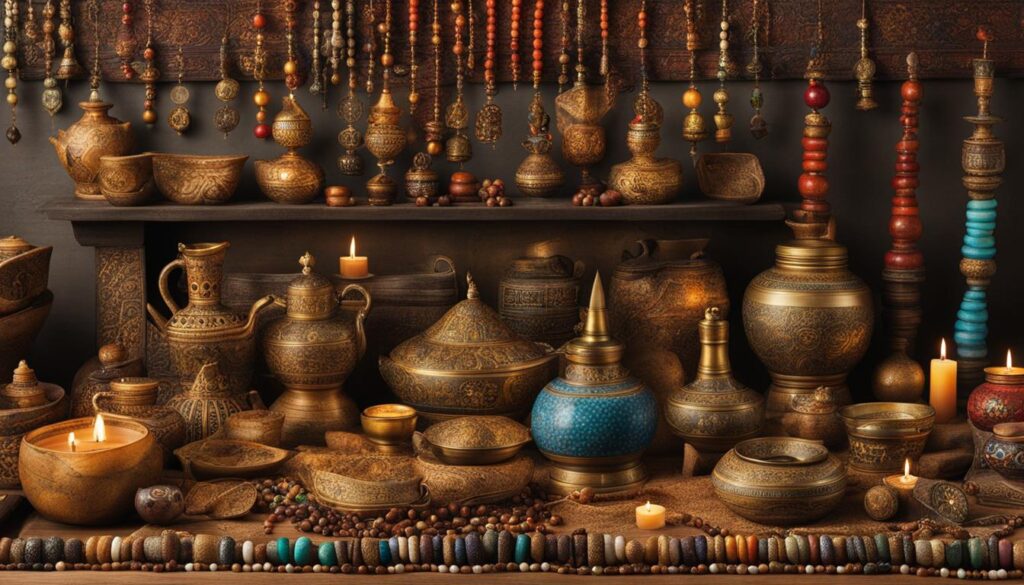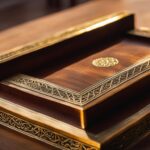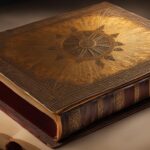The Internet offers a vast collection of sacred texts from various religions and spiritual traditions. These texts hold immense wisdom and are considered sacred by millions of people around the world. From the Bible to the Quran, the Vedas to the Tao Te Ching, these texts provide a glimpse into the beliefs, teachings, and practices of different faiths. With easy access to digital libraries and online resources, individuals can now explore and delve into the profound messages and spiritual insights contained in these holy books.
Key Takeaways:
- Sacred texts are revered by millions of people worldwide.
- Various religions and spiritual traditions have their own sacred texts.
- The Internet provides easy access to explore and study these texts online.
- Sacred texts offer profound wisdom and insights into different faiths.
- Digital libraries and online resources make sacred texts more accessible than ever before.
What are the Main Prayer Tools?
Prayer tools are essential elements used in different religious and spiritual practices. These tools help individuals connect with their divine or higher power and channel their intentions, gratitude, and devotion. Common prayer tools include prayer beads, prayer rugs or mats, prayer books or scriptures, prayer candles, incense, and prayer wheels. These tools serve as tangible reminders of devotion and act as aids in focusing one’s mind and heart during prayer and meditation.
Table: Common Prayer Tools
| Prayer Tool | Description |
|---|---|
| Prayer Beads | Used for counting repetitions of prayers or chants. |
| Prayer Rugs or Mats | Create a sacred space for prayer and meditation. |
| Prayer Books or Scriptures | Read or recited to invoke specific prayers or passages. |
| Prayer Candles | Lit to symbolize the presence of the divine and focus intentions. |
| Incense | Burned to purify the space and create an atmosphere for prayer and meditation. |
| Prayer Wheels | Spun to release prayers and blessings into the world. |
Each prayer tool serves a specific purpose and holds deep spiritual significance within its respective tradition. These tools, when used with reverence and intention, can enhance the spiritual experience and deepen one’s connection with the divine. They provide individuals with physical and tangible ways to engage in religious and spiritual practices.
Whether it’s the repetitive motion of prayer beads, the act of laying a prayer mat, or the lighting of a candle, prayer tools become rituals in themselves, creating a sacred space and setting the tone for communication with the divine. They act as a bridge between the physical world and the spiritual realm, helping individuals focus their attention and cultivate a sense of presence.
How are Prayer Tools Used in Practice?
Prayer tools are an integral part of religious rituals and spiritual practices across different traditions. They are used in various ways to facilitate a deeper connection with the divine and to enhance the prayer experience. Here are some common prayer tools and how they are utilized:
Prayer Beads:
Prayer beads, such as the rosary in Catholicism or the mala in Hinduism and Buddhism, are often used to count repetitions of prayers or chants. The beads provide a tangible way to track the number of prayers or mantras recited, helping individuals maintain focus and concentration during their prayers.
Prayer Rugs or Mats:
In Islam, prayer rugs or mats are used to create a sacred space for prayer and meditation. These rugs are typically placed on the ground, facing Mecca, and provide a clean and designated area for Muslims to perform their prayers. The rug serves as a physical reminder of the sacredness of the act of prayer.
Prayer Books or Scriptures:
Prayer books or scriptures are read or recited to invoke specific prayers or passages. They serve as a guide and source of inspiration, providing individuals with the words and teachings to connect with the divine. Many religious traditions have their own prayer books or sacred texts that are used during prayer and meditation.
Prayer Candles:
Prayer candles are often lit to symbolize the presence of the divine or as a way to focus one’s intentions. The act of lighting a candle can be seen as a symbolic gesture of inviting the divine into the prayer space and bringing light and clarity to one’s prayers. Candles are commonly used in both personal and communal prayer settings.
These are just a few examples of prayer tools and their usage in religious rituals and spiritual practices. Each prayer tool serves a specific purpose and holds symbolic significance within its respective tradition, enhancing the prayer experience and deepening the connection with the divine.
Main Prayer Tools
Prayer tools hold special significance in religious and spiritual practices, providing a means for individuals to connect with the divine and deepen their spiritual experience. There are several main prayer tools commonly used across different traditions, each with its own unique purpose and symbolism.
Prayer Beads
One of the most widely recognized prayer tools is the prayer beads. Used in various forms in different traditions, including the Catholic rosary and the Hindu mala, prayer beads are often used to count repetitions of prayers or mantras. The beads themselves symbolize the interconnectedness of all beings and serve as a reminder to maintain focus and discipline during prayer.
Prayer Rugs or Mats
In Islam, prayer rugs or mats are an essential tool for creating a sacred space for prayer. These rugs, often made from wool or cotton, symbolize the intimate connection between the individual and the divine. By unrolling the prayer rug and facing Mecca, Muslims enter into a state of devotion and engage in prayer and meditation.
Prayer Books or Scriptures
Prayer books or scriptures are another important prayer tool, representing the written word of God or the teachings of enlightened beings. These sacred texts are used to invoke specific prayers or recite passages that inspire spiritual reflection and connection with the divine. Prayer books symbolize the wisdom and guidance offered by these sacred texts.
Prayer Candles
Prayer candles are frequently used in various religious traditions, serving as a symbol of light and divine presence. Lighting a prayer candle represents the illumination of the spiritual path and the guidance sought from the divine. The flickering flame also helps to focus one’s intentions and create a serene and sacred atmosphere for prayer and meditation.
Incense
Incense is another prayer tool used in many religious and spiritual practices. As it burns and releases aromatic smoke, incense purifies the space and creates a serene environment for prayer and meditation. The fragrant smoke is believed to carry prayers and intentions to the spiritual realm, enhancing the connection between the individual and the divine.

| Prayer Tool | Symbolism |
|---|---|
| Prayer Beads | Interconnectedness of all beings; focus and discipline during prayer |
| Prayer Rugs or Mats | Intimate connection with the divine; sacred space for prayer |
| Prayer Books or Scriptures | Divine wisdom and teachings; guidance in spiritual reflection |
| Prayer Candles | Light and divine presence; illumination of the spiritual path |
| Incense | Purification; transmission of prayers to the spiritual realm |
Variations Among Sects in the Use of Prayer Tools
Within different religious traditions, variations can be found among sects or denominations in the use of prayer tools. While the basic purpose and symbolism of these tools remain consistent, specific variations have emerged over time. Understanding these variations can provide insights into the diversity and richness of religious practices.
Christianity
In Christianity, prayer beads are commonly used by different sects, but the design and structure of these beads can vary. For example, the Catholic rosary consists of a string of beads with sets of larger beads and a crucifix, while Anglican prayer beads typically have a circular design with additional beads representing different prayers. These variations in design reflect the unique practices and traditions of each sect within Christianity.
Islam
In Islam, prayer rugs or mats are widely used for daily prayers, but there are variations in their design and patterns. Different sects may have prayer rugs that reflect regional or cultural influences. For example, prayer rugs in Turkey often feature intricate geometric patterns, while those in Morocco may incorporate vibrant colors and traditional motifs. These variations add cultural diversity to the practice of prayer within the Islamic faith.
Buddhism
Buddhism also has variations in the use of prayer tools among different sects. For instance, Tibetan Buddhism is known for its use of prayer wheels, cylindrical devices inscribed with prayers and mantras. In contrast, Zen Buddhism may place greater emphasis on mindfulness meditation and the use of simple meditation cushions or benches, reflecting a more minimalist approach to prayer and spiritual practice. These variations reflect the diverse paths within Buddhism and the unique expressions of each sect’s teachings.
| Religious Tradition | Variations in Prayer Tools |
|---|---|
| Christianity | Design and structure of prayer beads (e.g., Catholic rosary vs. Anglican prayer beads) |
| Islam | Design and patterns of prayer rugs or mats |
| Buddhism | Presence or absence of prayer wheels, variations in meditation tools (e.g., cushions, benches) |
These examples highlight just a few variations among sects within different religious traditions. It is important to recognize and respect these differences, as they contribute to the richness and diversity of religious practices.
What Materials are Used for These Tools?
Prayer tools are crafted from a variety of materials, each chosen for its symbolism, durability, and cultural significance. The choice of materials varies among different religious traditions and can often be influenced by local customs and availability. Here are some common materials used for prayer tools:
| Prayer Tool | Materials |
|---|---|
| Prayer Beads | Gemstones, wood, precious metals |
| Prayer Rugs or Mats | Wool, cotton |
| Prayer Books | Parchment, paper, digital formats |
| Prayer Candles | Wax, natural materials |
| Incense | Aromatic plant resins, herbs |
These materials are carefully chosen to enhance the prayer experience and evoke a sense of sacredness. For example, prayer beads made from gemstones or precious metals can add beauty and elegance to the act of prayer. Prayer rugs crafted from wool or cotton provide a comfortable and soft surface for prayer and meditation. The use of parchment or paper in prayer books reflects the reverence for written words and the importance of preserving sacred knowledge. Natural materials like wax and aromatic plant resins contribute to the sensory experience, creating an atmosphere conducive to prayer and meditation.
It’s important to note that the choice of materials for prayer tools is not only influenced by their physical properties but also by their spiritual significance within each religious tradition. These materials carry symbolic meaning, connecting individuals to their faith and invoking a deeper connection with the divine.
Evolution of Prayer Tool Materials
Over time, the materials used for prayer tools have evolved alongside changes in technology, culture, and religious practices. In the past, prayer tools were often crafted from natural resources that were readily available in the local environment. As societies developed and trade networks expanded, new materials were introduced, bringing a wider range of options for prayer tool construction.
The evolution of materials for prayer tools can also be influenced by factors such as economic considerations and global trends. For example, advancements in manufacturing techniques have made it possible to produce prayer beads and other tools using synthetic materials that mimic the appearance of natural gemstones or precious metals. This allows for greater affordability and accessibility while still maintaining the desired aesthetic and functionality.
While traditional materials continue to be valued for their authenticity and historical significance, the use of modern materials has brought about new possibilities for creativity and innovation in prayer tool design. Today, practitioners can choose from a variety of prayer tools made from both traditional and contemporary materials, allowing for personal expression and customization of their spiritual practices.
How Have Prayer Tools Changed Over Time?
Prayer tools have a rich history of evolution and adaptation, reflecting changes in religious practices, cultural influences, and technological advancements. Throughout the centuries, prayer tools have transformed in design, materials used, and even their functional purposes. This evolution showcases the dynamic nature of religious traditions and the way they respond to the needs and preferences of their followers.
One significant aspect of the evolution of prayer tools is their physical form and design. For example, prayer beads have taken on various shapes and materials over time. In ancient times, cultures used knotted cords as a means of counting prayers and chants. As Christianity and other faiths adopted prayer beads, they evolved into intricate designs made from precious metals, gemstones, or wooden beads.
Another dimension of the evolution of prayer tools is their functionality. For instance, prayer books have transitioned from handwritten manuscripts to printed editions and, more recently, digital formats. This development has made sacred texts more accessible and convenient, allowing individuals to carry entire libraries of religious texts in their pockets.
| Prayer Tool | Evolution |
|---|---|
| Prayer Beads | From simple knotted cords to intricate designs made from precious metals and gemstones |
| Prayer Books | Transition from handwritten manuscripts to printed editions and now digital formats for accessibility |
| Prayer Rugs | Changes in design and materials, reflecting cultural shifts and artistic expressions |
As religious practices continue to evolve and adapt, prayer tools will likely continue to transform alongside them. Technology will play an increasingly significant role, providing new ways to engage with sacred texts and spiritual practices.
The evolution of prayer tools has always been influenced by cultural and societal changes. As different sects emerged within religious traditions, prayer tools took on unique variations. For example, within Buddhism, different sects developed their specific types of prayer wheels and prayer beads. These variations highlight the diversity within religious traditions and the ways in which different communities interpret and practice their faith.
While the core purpose of prayer tools remains unchanged – to facilitate prayer, meditation, and connection with the divine – their evolution showcases how religious traditions adapt to the world around them. As technology continues to advance and our understanding of spirituality deepens, we can expect further innovation and evolution in the realm of prayer tools.

Unique and Lesser-Known Prayer Tools in Different Spiritual Traditions
While many prayer tools are well-known and widely used across various religious and spiritual traditions, there are also unique and lesser-known tools that hold deep significance within their respective practices. These tools offer alternative ways to engage in prayer, meditation, and spiritual contemplation, providing individuals with diverse avenues to connect with the divine.
Hinduism: The Sacred Conch Shell (Shankha)

In Hinduism, the conch shell, also known as the Shankha, is a revered instrument used in religious rituals and prayers. The shell is believed to emit a divine sound that represents the primordial sound of creation. It is blown during ceremonies and acts as a call to prayer, awakening spiritual awareness, and invoking the presence of the divine.
Sufism: The Meditative Ney
In Sufism, a mystical branch of Islam, the ney is a unique musical instrument often used in spiritual practices. The ney is a reed flute known for its enchanting sound, which is believed to induce meditative states and spiritual receptivity. It is played during Sufi gatherings and ceremonies, creating an atmosphere conducive to inner reflection and spiritual awakening.
Tibetan Buddhism: The Prayer Flags
Tibetan Buddhism is known for its vibrant prayer flags, which are inscribed with prayers, mantras, and blessings. Prayer flags are considered sacred and are hung in outdoor spaces, where the wind carries the prayers and blessings to all beings. They serve as a visual reminder of the interconnectedness of all life and foster a sense of peace, compassion, and spiritual well-being.
| Religious Tradition | Unique Prayer Tool | Description |
|---|---|---|
| Hinduism | Conch Shell (Shankha) | The conch shell is blown during ceremonies and prayers, symbolizing divine presence and the primordial sound of creation. |
| Sufism | Ney | The ney is a reed flute played during Sufi gatherings, inducing meditative states and spiritual receptivity. |
| Tibetan Buddhism | Prayer Flags | Flags inscribed with prayers and blessings, hung outdoors to spread peace, compassion, and interconnectedness. |
These unique prayer tools showcase the diverse ways in which individuals from different spiritual traditions seek connection, inspiration, and transcendence. While they may be lesser-known outside of their respective practices, they hold deep spiritual significance and provide alternative paths to divine communion. By exploring these lesser-known prayer tools, individuals can expand their understanding of spirituality and cultivate a richer, more inclusive spiritual practice.
Conclusion
Sacred texts and prayer tools hold immense spiritual wisdom and play a vital role in various religious and spiritual traditions. These texts offer profound insights into the beliefs, teachings, and practices of different faiths, allowing individuals to seek guidance and deepen their understanding of their own faith. With the advent of technology, the accessibility of sacred texts has increased, enabling people from diverse backgrounds to explore and engage with these revered writings online.
Prayer tools, such as prayer beads, rugs, candles, and books, serve as gateways to spirituality. They allow individuals to establish a connection with the divine, channel their intentions, and cultivate a focused and disciplined mindset during prayer and meditation. These tools symbolize different aspects within their respective traditions, whether it is the interconnectedness of all beings represented by prayer beads or the purification and transmission of prayers embodied by incense.
While the core purpose and symbolism of prayer tools remain consistent, there can be variations among sects or denominations within a religious tradition. Different sects may have their own unique designs or specific prayer tools, reflecting regional or cultural influences. Furthermore, prayer tools have evolved over time to adapt to changing religious practices, cultural shifts, and technological advancements. From handwritten manuscripts to digital formats, prayer tools have embraced new forms while retaining their essence.
In addition to well-known prayer tools, there are lesser-known instruments that hold deep spiritual significance within specific traditions. For instance, the conch shell in Hinduism or the ney in Sufism offer unique ways to engage in prayer and create a meditative atmosphere. These lesser-known tools provide further avenues for spiritual exploration and expression.
FAQ
What are some common prayer tools?
Common prayer tools include prayer beads, prayer rugs or mats, prayer books or scriptures, prayer candles, incense, and prayer wheels.
How are prayer tools used in religious and spiritual practices?
Prayer beads are often used to count repetitions of prayers or chants. prayer rugs or mats create a sacred space for prayer and meditation. Prayer books or scriptures are read or recited to invoke specific prayers or passages. Prayer candles are lit to symbolize the presence of the divine. Incense is burned to purify the space and create an atmosphere conducive to prayer. Prayer wheels are spun to release prayers and blessings into the world.
What do prayer tools symbolize?
Prayer beads symbolize interconnectedness and focus during prayer. Prayer rugs or mats symbolize direct contact with the divine. Prayer books or scriptures symbolize the teachings of God or enlightened beings. Prayer candles represent light and divine guidance. Incense symbolizes purification and the transmission of prayers. Each prayer tool carries its own unique symbolism.
Are there variations in the use of prayer tools among different religious sects?
Yes, different sects or denominations within a religious tradition may have their own variations of prayer tools. For example, different sects within Christianity may have their own versions of prayer beads.
What materials are prayer tools made from?
Prayer tools are made from a wide range of materials, including wood, gemstones, precious metals, fabric, parchment, paper, wax, aromatic plant resins, and herbs.
How have prayer tools changed over time?
Prayer tools have adapted to changes in religious practices, cultural influences, and technological advancements. For example, prayer beads have taken on different forms and designs, and prayer books have transitioned from handwritten manuscripts to digital formats.
Are there lesser-known prayer tools?
Yes, there are lesser-known prayer tools that are unique to specific religious or spiritual traditions, such as the conch shell in Hinduism or the ney in Sufism.
How do sacred texts and prayer tools contribute to spiritual practice?
Sacred texts and prayer tools provide spiritual guidance, help individuals connect with the divine, and deepen their understanding of their faith.









